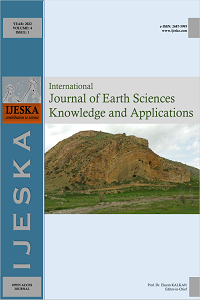Participation and Challenges of Women in Environmental Management: A Case of Buhera South District, Manicaland Province, Zimbabwe
Abstract
Women form the backbone of most land restoration efforts in Africa’s rural communities. In agriculture and land rehabilitation, they offer at least 60-80% of the world’s labour. However, women in rural areas are facing multiple obstacles in accessing finance and environmental education which is essential input to increase information dissemination to curb environmental degradation. The study assesses the position of women in environmental management within in rural communities was carried out in May 2021. The focus area for the study was ward 30 of Buhera South District, Manicaland Province. Interviews and questionnaires were used to gather data of women’s precipitations, participation and challenges their faced in their involvement in environmental management. Both primary and secondary data were used in the analysis. Purposive sampling was used to isolate the 5 villages. A sample of 100 respondents were randomly selected and gave a response rate of 80%. A self-administered questionnaire was used in conjunction with the focus group discussion. The results showed that mostly women participated in environmental management projects. There was strong evidence to support that women’s participation as could be improved through incentives for participation. Giving women more property rights in rural areas may also improve participation as it would give them a sense of ownership. There was a positive correlation between willingness to participate in environmental management issues and level of education. Impowering women through incentives, land rights and education may yield positive results in protection the environment and sustainably managing Africa’s natural resources.
References
- Baynes, J., Herbohn, J., Smith, C., Fisher, R., Bray, D., 2015. Key factors which influence the success of community forestry in developing countries. Global Environmental Change 35, 226-238.
- Behrman, J., 2012. The gender implications of large-scale land deals. Journal of Peasant Studies 39(January):49-79.
- Chant, S., Sweetman, C., 2012. Fixing women or fixing the world? “Smart economics”, efficiency approaches, and gender equality in development. Gender and Development 20 (3), 517-29.
- Coleman, E.A., Mwangi, E., 2013. Women’s participation in forest management: A cross-country analysis. Global Environmental Change 23, 193-205.
- Census, 2012. Zimbabwe Population Census 2012, National Report, Population Census Office, Causeway, Harare, Zimbabwe.
- EMA, 2007. Environmental Management Act (EMA), Environmental Management Regulations 2007, Statutory Instrument 10:2007, Chapter 20:27. Government Printer, Harare, Zimbabwe.
- FAO, 2005. Food and Agriculture Organization of the United Nations. The State of Food and Agriculture 2005. Rome.
- FAO, 2008. Food and Agricultural Organization. The State of Food and Agriculture 2008 Production Year Book Vol. 57, Rome.
- FAO, 2009. Food and Agricultural Organization. Contract Farming: Partnership for Growth, Rome.
- Gaveau, D.L.A., Pirard, R., Salim, M.A., Tonoto, P., Yaen, H., Parks, S.A., Carmenta, R., 2017. Overlapping land claims limit the use of satellites to monitor No-Deforestation commitments and No-Burning compliance. Conservation Letters 10 (2), 257-264.
- Giri, K., 2012. Gender in forest tenure: Prerequisite for sustainable forest management in Nepal. Brief #1 of 4 of The Challenges of Securing Women’s Tenure and Leadership for Forest Management: The Asian Experience. Rights and Resources Initiative, Washington, DC, 22 p.
- Green Climate Fund, 2015. Consideration of Funding Proposals-Addendum. Funding Proposal Package for FP003, GCF/B.11/04/Add.03. 15 October 2015.
- Hekman, S.J., 1990. Gender and Knowledge: Elements of a Postmodern Feminism. Polity Press. Cambridge. IUCN, 2016. Inclusion and characterization of women and gender equality considerations in National Biodiversity Strategies and Action Plans (NBSAPs).
- Kevane, M., 2004. Women and development in Africa: How gender works. Boulder, Colo., U.S.A., and London: Lynne Rienner.
- Khadka, M., Karki, S., Karky, B.S., Kotru, R., Darjee, K.B., 2014. Gender equality challenges to the REDD+ initiative in Nepal. Mountain Research and Development 34 (3), 197-207.
- Khasiani, S.A., 1992. Groundwork: African Women as Environmental Managers. ACTS Press. Nairobi.
- Maathai, W., 1988. The Green Belt Movement: Sharing the Approach and the Experience. Environmental Liaison Centre International. Nairobi.
- Mmasa, J.J., 2013. Women Participation in Agriculture in Tanzania - Challenges and policy recommendations - Tanzania Country Level Knowledge Network - CLKnet Policy Brief No 8:2013 CLKnet - Policy Brief No:8. Available: http://clknet.or.tz.
- Moser, C., 1993. Gender Planning and Development: Theory, Practice and Training. Routledge, London.
- Picard, M., 1996. A Guide to the Gender Dimension of Environment and Natural Resources Management. USAID, Amex International Inc.
- Pısa, L., Katsande, S., 2021. Human Wildlife Conflict in Relation to Human Security in the Gonarezhou National Park, Zimbabwe. International Journal of Earth Sciences Knowledge and Applications 3 (2), 98-106.
- Rao, N., 2017. Assets, agency and legitimacy: Toward a relational understanding of gender equality policy and practice. World Development 95, 43-54.
- Saeed, A.R., McDermott, C., Boyd, E., 2017. Are REDD+ community forest projects following the principles for collective action, as proposed by Ostrom? International Journal of the Commons 11, 572-596.
- Sontheimer, S., 2005. Women and the Environment: A Reader-Crisis and Development in the Third World. Earthscan Publications Ltd. London.
- UNEP 2000. Global Environmental Outlook 2000. Available: https://www.unep.org/resources/global-environment-outlook-2000.
Details
| Primary Language | English |
|---|---|
| Subjects | Geological Sciences and Engineering (Other) |
| Journal Section | Research Article |
| Authors | |
| Publication Date | November 1, 2021 |
| Published in Issue | Year 2022 Volume: 4 Issue: 1 |


